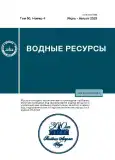A FCM Runoff Model for Small Rivers with Rainfall Recharge. 1. The Concept and Algorithms
- 作者: Gartsman B.I.1
-
隶属关系:
- Water Problems Institute, Russian Academy of Sciences, 119333, Moscow, Russia
- 期: 卷 50, 编号 4 (2023)
- 页面: 395-406
- 栏目: МАТЕМАТИЧЕСКИЕ МОДЕЛИ В РЕШЕНИИ ЗАДАЧ ГИДРОЛОГИИ СУШИ
- URL: https://journals.rcsi.science/0321-0596/article/view/134867
- DOI: https://doi.org/10.31857/S0321059623040089
- EDN: https://elibrary.ru/QKNCYW
- ID: 134867
如何引用文章
全文:
详细
The flood cycle model FCM is a lumped conceptual water-balance model designed to simulate rain runoff at a scale of a small river basin. The development of the FCM model includes the description of the dynamics of the major components of the total moisture reserves of a basin and reproduces the effect of spatial expansion of the drainage network through temporary surface and subsurface streams during extraordinary floods. The accepted conceptual assumptions of the model, which are in agreement with the rational hydrological considerations, lead to three runoff-formation regimes, referred to as intravolume, surface and breakthrough. The concept and algorithms of FCM are given in detail.
作者简介
B. Gartsman
Water Problems Institute, Russian Academy of Sciences, 119333, Moscow, Russia
编辑信件的主要联系方式.
Email: gartsman@inbox.ru
Россия, 119333, Москва
参考
- Баренблатт Г.И. Автомодельные явления – анализ размерностей и скейлинг. Долгопрудный: Изд. Дом “Интеллект”, 2009. 216 с.
- Гарцман Б.И. Дождевые наводнения на реках юга Дальнего Востока: методы расчетов, прогнозов, оценок риска. Владивосток: Дальнаука, 2008. 223 с.
- Гарцман Б.И., Шамов В.В., Губарева Т.С. и др. Речные системы Дальнего Востока России: четверть века исследований. Владивосток: Дальнаука, 2015. 492 с.
- Кучмент Л.С., Демидов В.Н., Мотовилов Ю.Г. Формирование речного стока. Физико-математические модели. М.: Наука, 1983. 216 с.
- Мотовилов Ю.Г., Гельфан А.Н. Модели формирования стока в задачах гидрологии речных бассейнов. М.: Изд-во РАН, 2018. 300 с.
- Шамов В.В. Влагооборот на суше. Системно-методологический и физико-геометрический анализ. Владивосток: Дальнаука, 2006. 196 с.
- Beven K.J. Rainfall-runoff Modelling: The Primer. Chichester: Wiley&Sons, 2001. 488 p.
- Bloeschl G. 133 Rainfall-runoff Modelling of Ungauged Catchments // Encyclopedia of Hydrol. Sci / Ed. M.G. Anderson, J.J. McDonnell. New York: John Wiley, 2005. P. 2061–2080. https://doi.org/10.1002/0470848944.hsa140
- Brutsaert W. Hydrology: An Introduction. Cambridge: Cambridge Univ. Press, 2005. 605 p.
- Clark M.P., Rupp D.E., Woods R.A., Tromp-van Meerveld H.J., Peters N.E., Freer J.E. Consistency between hydrological models and field observations: linking processes at the hillslope scale to hydrological responses at the watershed scale // Hydrol. Proc. 2009. V. 23 (2). P. 311–319. https://doi.org/10.1002/hyp.7154
- Kirchner J.W. Catchments as simple dynamical systems: Catchment characterization, rainfall-runoff modeling, and doing hydrology backward // Water Resour. Res. 2009. V. 45 (2). W02429. https://doi.org/10.1029/2008WR006912
- Kirchner J.W. Getting the right answers for the right reasons: Linking measurements, analyses, and models to advance the science of hydrology // Water Resour. Res. 2006. V. 42 (3). W03S04. https://doi.org/10.1029/2005WR004362
- Lehmann P., Hinz C., McGrath G., Tromp-van Meerveld H.J., McDonnell J.J. Rainfall threshold for hillslope outflow: an emergent property of flow pathway connectivity // Hydrol. Earth Syst. Sci. 2007. V. 11. P. 1047–1063. https://doi.org/10.5194/hess-11-1047-2007
- Mathematical models of small watershed hydrology // Eds V.P. Singh, D.K. Frevert. Highlands Ranch: Water Resour. Publ., 2001. 972 p.
- McDonnell J.J. A rationale for old water discharge through macropores in a steep, humid catchment // Water Resour. Res. 1990. V. 26 (11). P. 2821–2832. https://doi.org/10.1029/WR026i011p02821
- McDonnell J.J., Sivapalan M., Vache K. et al. Moving beyond heterogeneity and process complexity: A new vision for watershed hydrology // Water Resour. Res. 2007. V. 43 (7). W07301. https://doi.org/10.1029/2006WR005467
- Rodriguez-Iturbe I., Rinaldo A. Fractal River Basins: Chance and Self-organization. Cambridge: Cambridge Univ. Press, 1997. 570 p.
- Schmocker-Fackel P., Naef F., Scherrer S. Identifying runoff processes on the plot and catchment scale // Hydrol. Earth Syst. Sci. 2007. V. 11. P. 891–906. https://doi.org/10.5194/hess-11-891-2007
- Spatial Patterns in Catchment Hydrology: Observations and Modelling // Ed. R.B. Grayson, G. Blöschl. Cambridge: Cambridge Univ. Press, 2000. 423 p.
- Tromp-van Meerveld H.J., McDonnell J.J. Threshold relations in subsurface stormflow: 1. A 147-storm analysis of the Panola hillslope // Water Resour. Res. 2006. V. 42. W02410. https://doi.org/10.1029/2004WR003778
- Wagener T., Wheater H.S., Gupta H.V. Ranfall-runoff Modelling in gauged and ungauged catchments. London: Imperial College Press, 2004. 332 p.
- Weiler M., McDonnell J.J. Conceptualizing lateral preferential flow and flow networks and simulating the effects on gauged and ungauged hillslopes // Water Resour. Res. 2007. V. 43 (3). W03403. https://doi.org/10.1029/2006WR004867
- Wittenberg H. Baseflow recession and recharge as nonlinear storage processes // Hydrol. Proc. 1999. V. 13 (5). P. 715–726. https://doi.org/10.1002/(SICI)1099-1085(19990415)13:5<715::AID-HYP775>3.0.CO;2-N
补充文件













